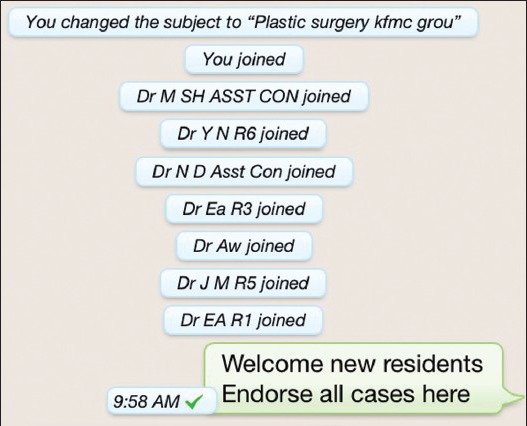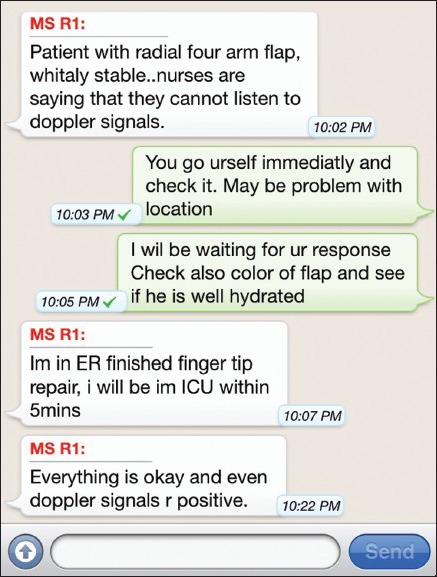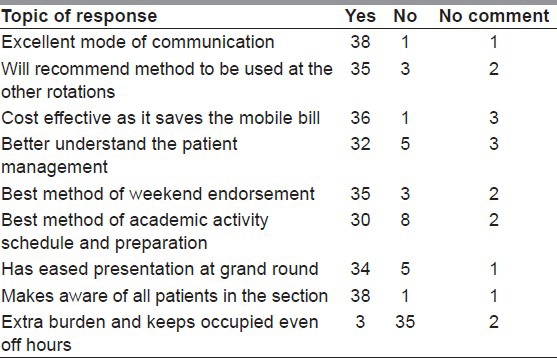Abstract
Objective:
The objective of this study is to assess the efficacy of smartphone and its WhatsApp application as a communication method amongst the staff of plastic and reconstructive surgery section at tertiary care health facility.
Materials and Methods:
From January 2012 onwards, the authors used smartphones and its WhatsApp application as a communication method amongst their team for various aspects of patient management and as a tool for academic endorsements.
Results:
During the period of this study, there were 116 episodes regarding patient management, which were handled, in a timely fashion by using this application. In addition opinion of rotating residents in the section was sought regarding the efficacy of this method of communication. Overall majority of residents were satisfied with this mode of communication.
Conclusions:
This new method of communication is an effective method for clinical and academic endorsements. The method is cheap and quick and easy to operate.
KEY WORDS: Communication method, multimedia, smartphone, WhatsApp
INTRODUCTION
For communication between the members of any division in the surgical field, perhaps the most frequently used method is a verbal report via telephones. Telephone communication can be rapid but not objective and precise. To add more accurate information to the verbal report, clinical photographs taken by digital cameras were transmitted as downloadable files between computers having modem and telephone link as telemedicine has gained popularity in the late 1990's.[1]
With advance in internet access in late 2000s, images were transferred through internet lines by commonly used internet portals accessed by personal computers or by mobile phones. More recently photographs taken by smartphone were transferred to another smartphone.[2,3]
WhatsApp is an early stage technology startup founded to build a better short message service alternative. It is a proprietary cross platform instant messaging application for smart phones. Santa Clara, California based company WhatsApp Inc. that was founded in 2009 by Brian Acton and Jan Koum[4] developed it.
In this study, we discussed our communication method reflecting the latest mobile environment using a smartphone and WhatsApp. In addition, we analyzed the influence of this method on the time limit of management of any untoward incident happening in patient management.
MATERIALS AND METHODS
This study was conducted at plastic surgery section of a tertiary care health facility. From January 2012, communication system among the residents, Assistant Consultants and Associate Consultants was totally changed. The senior author of the study opened a group on WhatsApp and named it plastic surgery group. All Assistant Consultants and Associate Consultants were included in the group. The rotating residents were included 1-week prior to joining the division in the group; so that they will have pre-joining endorsement of cases. Their names were deleted from the group once they finish the rotation in the section. Both off service residents (residents rotating in plastic surgery from other specialties) and plastic surgery residents (Junior and Senior) were included in the group [Figure 1].
Figure 1.

Participant information of WhatsApp group
On joining the group, they were instructed to endorse all the patients of the team, new consults, admissions, discharges, OR cases, plans, endorsement of cases over weekends, schedule of academic activities, uploading of pre-operative, intra-operative and post-operative photographs for documentation and grand round presentations.
Any untoward incident of patient and its management was always uploaded. All members of the group were strictly advised that at all stage of information sharing patient identity should remain confidential but information, which was uploaded was sufficient to know exactly about which patient's conversation is going on such as ward number, bed number, procedure done and consultant in charge.
Whenever any members of the group went to see any patient, he will share all information with the team members using this application. All members were in the connecting-on state and chatting window was activated immediately whenever someone typed or uploaded information so that near real time communication between members was possible [Figure 2]. In addition to word chat, images and video clip shots taken by smart phone were also attached with the conversation.
Figure 2.

Chating window
All members downloaded WhatsApp from Play store for Android for free and from App store for iOS for 0.99$. The internet facility was available at all locations in hospital campus and was also coming as 3G packages from mobile network operators on very low additional cost or for free. All members were instructed to keep WhatsApp application on in notification centre with a sound alert and respond to any information in a timely fashion. The information from on call junior residents was responded by on call Assistant Consultant or Associate Consultant immediately. If senior on call was not responding on WhatsApp for patient's events; he was contacted by on call junior resident on phone immediately. If an opinion from consultant was needed, the Assistant Consultant or Associate Consultant will be communicating with the consultant on the phone.
The chat conversations were photographed as screen shots by the senior author for study purposes and were analyzed on a weekly basis. The on call resident was documenting the events in patient's medical records on spot and any advice from senior on call and any interventions were also recorded. Efficacy of communication and time limit of management of important events was recorded. At the end of rotation of residents, they were given a questionnaire about the efficacy of this method of communication.
RESULTS
A total of 15 plastic surgery residents and 25 off service residents rotated in our section during this timeframe. Over this period, there were 116 important episodes got from the chat window concerning patient management, which needed timely intervention. Time limit analysis response from beginning of these episodes to response by second on call is in Table 1.
Table 1.
Response time from second on call

The time lapse between initial reporting and actual start of management of the problem is seen in Table 2.
Table 2.
Time interval between reporting of problem and actual start of management

At the completion of the rotation, all the 40 rotating residents were given a preset questionnaire about their opinion regarding use of this application method as a mode of communication. Their responses are shown in Table 3.
Table 3.
Response of resident to the efficacy of this mode of Communication (n=40)

DISCUSSION
The timing of the presentation of first signs complications is known to dictate the salvage of outcome of any surgical procedure. Our method of communication reduced the time interval between the first recognition of any untoward effect and starting the management. Before we started this method of communication at our division, we were using pager system to communicate with each other. This was only verbal communication and one-to-one contact.
The redundant steps of vertical reporting system were eliminated by real time WhatsApp chat. There was input from all residents and registrars based on high quality information including photographs, videos and chats. The verbal presentation of any events had no competitive power in comparison with comprehensive WhatsApp chat system. This method of communication resulted in early detection of problems and starting earliest management. But one thing should be kept in mind that in case of critical issues messages of any type cannot replace a personal conversation.
At our institute informed consent was taken from all patients for taking photographs and sharing of the image with other members of the team. As this method is a closed circuit communication and all patient information was confidential there were no adverse medico legal aspects of this tool.
The disadvantage of this tool was that one has to remain logged on to Internet round the clock. Another disadvantage of this system is that conversation cannot form the part of medical record, as it cannot be printed directly. Unless each message contains enough identity features of patient being discussed, the chat system may complicate the communication once discussion is going about multiple patients.
We reviewed the literature to find if this method has been used before in any medical field. But there was no reported evidence. In plastic surgery literature messaging system has been used for free flap monitoring communication and has been found very effective tool.[5]
Innovation similar to this modality discussed in this report have been used earlier in interpreting radiological images in the emergency room, which used images displayed on a picture archiving and communication system monitor captured by a camera and transferred to remote physicians through wireless higher bandwidth network.[6] Hsieh et al.[7] has used Teleconsultation in plastic surgery using images from inbuilt camera of cellphones.
In addition, this method has made life of both off-service residents and plastic surgery residents easy. Majority of them were convinced that the chat system was effective teaching method in the evaluation of patients, quick and complete endorsement of patients and availability of photographs and videos for presentation. Majority of residents were very enthusiastic and were of the opinion that they will recommend that this method of communication should be used in their parent hospitals and in their rotating hospitals.
The limitation of this study is that there was no control sample to compare speed of initiation of patient management in pre-WhatsApp era. If there was one, we could see statistically difference between the two methods.
This method can be used for seeking advice from the consultants living at a distance from the hospital so that they can give their expert opinion without physically being present. In future, this can be used for management of trauma and disaster to start pre-hospital management.
CONCLUSIONS
For quick communication amongst staff members, we used smartphone and WhatsApp chat and multimedia application for patient care and academic endorsement. We found out that it was very effective and satisfying to all staff members. Moreover, any notification of patient's events was quick and start of management was earlier with this method. We recommend that this method should be used in other specialties for both academic and clinical endorsements. However, there is a point of caution that messages of any sort cannot replace a personal conversation in case of critical issues.
Footnotes
Source of Support: Nil,
Conflict of Interest: Nil.
REFERENCES
- 1.Baldwin AJ, Langton SG. Postoperative monitoring of flaps by digital camera and Internet link. Br J Oral Maxillofac Surg. 2001;39:120–1. doi: 10.1054/bjom.2000.0610. [DOI] [PubMed] [Google Scholar]
- 2.Varkey P, Tan NC, Girotto R, Tang WR, Liu YT, Chen HC. A picture speaks a thousand words: The use of digital photography and the Internet as a cost-effective tool in monitoring free flaps. Ann Plast Surg. 2008;60:45–8. doi: 10.1097/SAP.0b013e31805003df. [DOI] [PubMed] [Google Scholar]
- 3.Engel H, Huang JJ, Tsao CK, Lin CY, Chou PY, Brey EM, et al. Remote real-time monitoring of free flaps via smartphone photography and 3G wireless Internet: A prospective study evidencing diagnostic accuracy. Microsurgery. 2011;31:589–95. doi: 10.1002/micr.20921. [DOI] [PubMed] [Google Scholar]
- 4.Wikipedia, the free encyclopedia en. [Last updated on 2013 Mar 21]. Available from: http://www.Wikipedia.org/wiki/Whats App .
- 5.Knobloch K, Gohritz A, Vogt PM. Cell phone-based multimedia messaging service in reconstructive microsurgery: A novel telemedicine application. Plast Reconstr Surg. 2009;123:220e–2. doi: 10.1097/PRS.0b013e3181a3f53b. [DOI] [PubMed] [Google Scholar]
- 6.Kim DK, Yoo SK, Kim SH. Instant wireless transmission of radiological images using a personal digital assistant phone for emergency teleconsultation. J Telemed Telecare. 2005;11(Suppl 2):S58–61. doi: 10.1258/135763305775124786. [DOI] [PubMed] [Google Scholar]
- 7.Hsieh CH, Tsai HH, Yin JW, Chen CY, Yang JC, Jeng SF. Teleconsultation with the mobile camera-phone in digital soft-tissue injury: A feasibility study. Plast Reconstr Surg. 2004;114:1776–82. doi: 10.1097/01.prs.0000142402.07896.21. [DOI] [PubMed] [Google Scholar]


